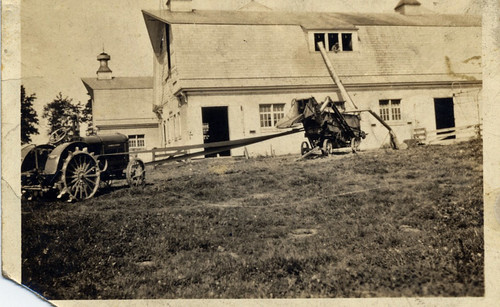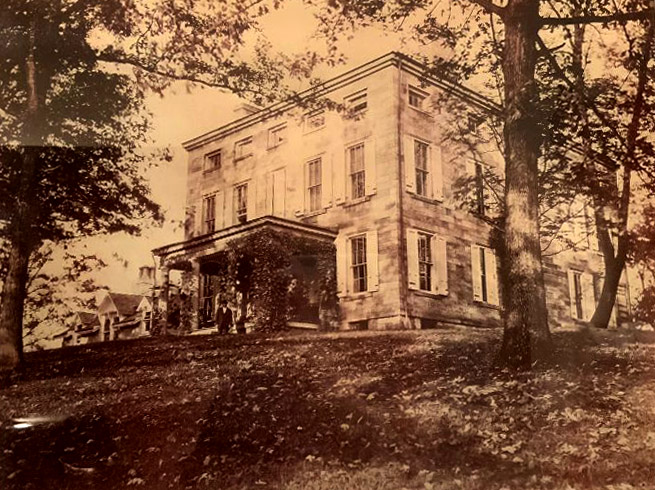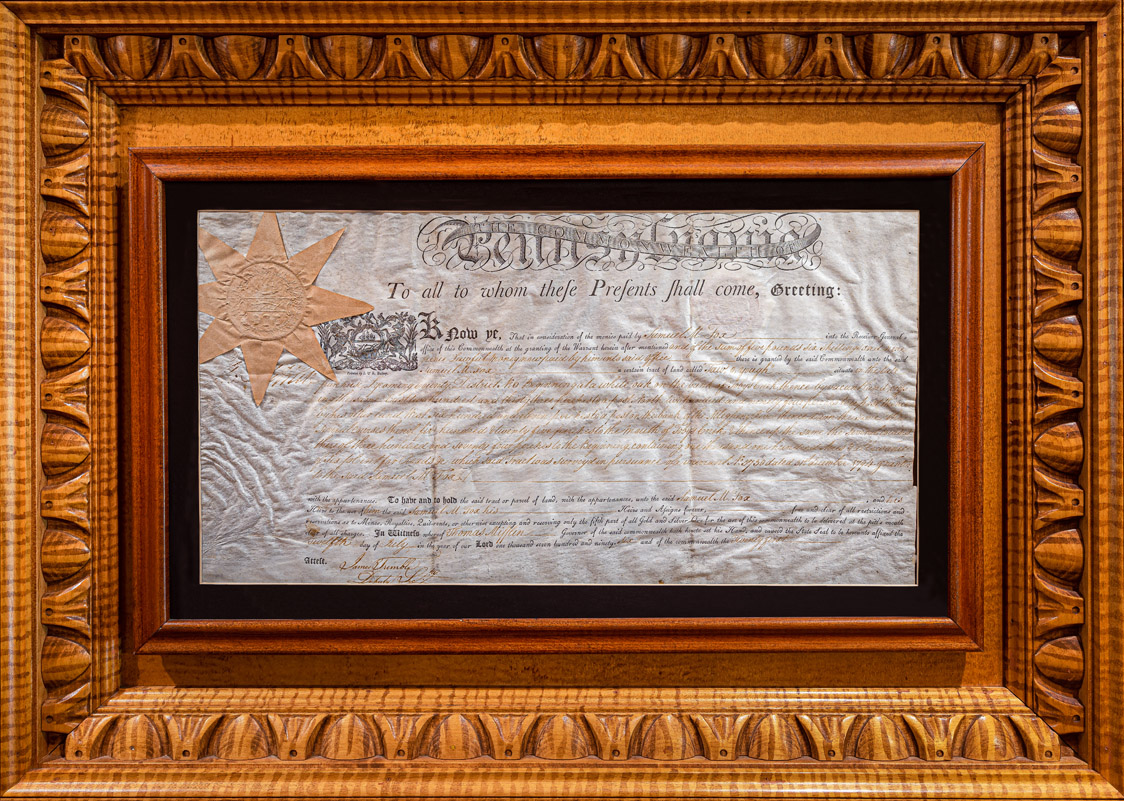| HISTORY
The Riverstone Estate was originally owned by the
prominent Fox family of Philadelphia, descendants of George Fox,
the founder of the Quaker religion. In 1796, Samuel Mickle Fox,
along with his brother George and brothers in law Joseph Parker
Norris and George Roberts, purchased a number of tracts of land
in western Pennsylvania from the Commonwealth. The land warrant
was for 6,600 acres located at the Allegheny River north of its
confluence with Toby's Creek, now the Clarion River. The property
became known as the Fox Farm. Click
here for Fox Family Papers Compiled by the Historical Society of
Pennsylvania.

In 1820, Samuel’s son, Joseph Mickle Fox, married Hannah
Emlenand and moved to the Clarion County property of his father
and began construction of the main stone house. The original mansion
was built with cut and squared sandstone from the property and was
completed in 1828. In 1845, the Fox family added five feet to the
north side of the house and twenty feet to the west side. This west
addition provided front rooms to all three floors. In 1877, a north
wing was added to the structure and, in 1910, a stairwell section
was constructed for this wing. The mansion basically remained in
this configuration over the next eighty years.

The Fox family used the property as a summer home, often making
the arduous trip from Philadelphia in two weeks. Aside from the
mansion, the Fox's built carriage houses, stables, an ice house,
a greenhouse, barns, and a log cabin used as a play area for the
Fox children. They enhanced the Estate by retaining, Frank Heyling
Furness, an acclaimed American architect, to design a signature
carriage house in 1876. A greenhouse designed by Lord & Burnham,
noted American manufacturers and builders of public conservatories
in the United States, also stands the property.

In the early 1900’s the Fox's brought the first Guernsey
dairy cows to the United States and in 1910 the long two-story dairy
barns. The barns were built with a pink colored stucco finish and
gable-type roofs and formed a traditional H. The Fox family also
added to their holdings and profited from harvesting the timber
and later, oil production on the farm. They went on to establish,
on the Estate, the first complete arboretum in the Commonwealth
and collected specimens of all trees indigenous to the area.

In 1847, the village of Foxburg was established by Joseph M. Fox.
A train station, located in the heart of town, which was once serviced
by two railroads, provided interest as well as transportation. Both
the Allegheny Division of the Pennsylvania Railroad and the Baltimore
and Ohio Railroad, were essential to Foxburg and the surrounding
area amidst the influx of oil development in Clarion County. This
charming town was once home to a unique two-level railroad bridge,
a signature attraction of the town for many years. The distinctive
feature of this remarkable structure is that it allowed rail traffic
to pass over its top and regular wagon and passenger traffic to
pass below. The bridges of Foxburg have changed over the years to
accommodate the need for transportation. Most recently, a new Foxburg
Bridge was constructed and some of the railroad tracks have been
converted to hiking and biking trails.

Recognized as philanthropists, the Fox family took great interest
in the community of Foxburg and built the Memorial Church of Our
Father, the Hannah Memorial Library, and the Foxburg Golf Club.
Built by the Fox Family in 1881, after their conversion to the
Episcopal faith, the Memorial Church of Our Father was dedicated
to the community by Joseph M. Fox in 1882. The design of this beautifully
crafted Gothic structure is based on a church Mrs. Fox remembered
fondly in England. The masonry stone used to construct this grand
Church is native to the area and the painting of the “Angel
of the Resurrection” above the alter is the work of a noted
artist of the time, Edwin H. Blashfied. The adjacent cemetery is
the resting place for some members of the Fox family.

The Hannah (Fox) Memorial Library, now know as The Foxburg Free
Library, was dedicated to the community in 1910. Similar to that
of the Fox Mansion, the library is constructed of gray stone from
the area. Some of the many ways the library has served the community
over the years include providing space for lectures, concerts, plays
and events that have contributed to the success of the library as
well as the community at large. In 1961, the Foxburg Library Association
joined the Clarion County Library District and now serves portions
of 4 counties including Clarion, Butler, Armstrong, and Venango.
The Library currently has a collection of approximately 4,000 books,
journals, audio tapes, and videos.

In the summer of 1884, Joseph Mickle Fox returned to the United
States after attending cricket tournaments in England and Scotland
with a new game . . . golf. He then went on to build a five hole
course on the meadows of his families’ estate. With enthusiasm
for the game rising, Joseph Fox provided the land upon which to
build a nine hole course and in 1887, the Foxburg Golf Club was
organized. Still in existence today, The Foxburg County Club is
home to the Golf Hall of Fame and continues to be recognized as
the oldest continuously operated golf course in the United States.

The Mansion was kept within the Fox family until 1964. The property
passed through several owners, including a lumber company until
purchased by Arthur and Patricia Steffee in 1996.

In the following years, the Steffees went on to restore and expand
this extraordinary river-front estate. Now known as the Riverstone
Estate, this property hosts a mansion, extensive equestrian complex,
carriage house, greenhouse, aviary and additional residences and
barns. The mansion was taken down to the bare stone walls and meticulously
renovated and enlarged to include state of the art amenities and
stunning interior and exterior architectural elements. The original
dairy barns were converted to stable horses and then became part
of the premier equestrian complex with the addition of a clear span
riding arena, two viewing rooms, vet space, horse showers and two
attached residences.

In disrepair at the time of purchase, the Steffees, used old photographs
to restore the period carriage house and greenhouse. The Carriage
House maintained both exterior and interior features incorporated
in the structure by
Frank Furness.

While the beauty and function, of design by
Lord & Burnham, was retained in the renovation
of the greenhouse. Now comprised of 26 structures, the RiverStone
Estate stands as a testament to innovative, architectural, and historic
integrity. The details of which are illustrated throughout our tour
of the Estate.

Deed from 1796

Deed from 1796 |
